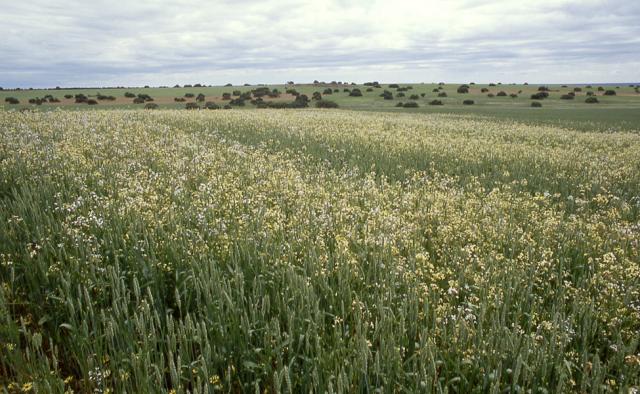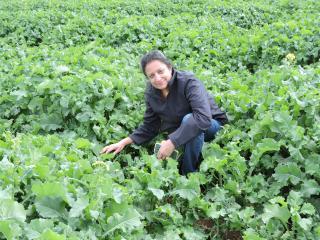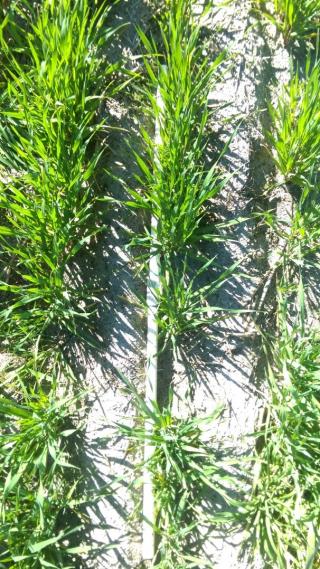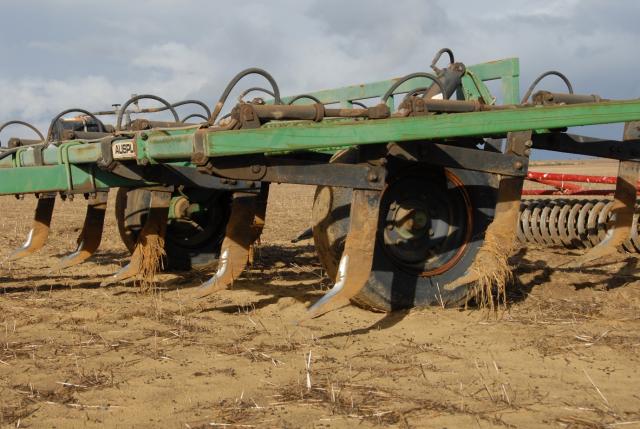Crop Competition
There are many options available to growers when they wish to maximise their crops potential. Crop sowing rate, decisions on row spacing and row orientation, plus a myriad of choices when it comes to soil amelioration and renovation. While these choices are primarily made to optimise crop yield there may be added benefits in terms of improved weed management or unexpected impacts from plant diseases.
This issue of Protecting WA Crops will focus on the effect of various practices on the competitive nature of crops towards weeds, pests and diseases.
The relative ability of a particular crop species to compete with weeds will vary with environmental conditions, crop agronomy and weed species. However, it is generally found that cereal crops are more competitive than other crop types, due to their early growth vigour and ability to intercept more light at earlier growth stage. In the WA grain-belt, when grown in the same trial, wheat and barley have been found to be more competitive with weeds than canola, field pea or lupin.
Crop density
Altering the crop density either through altered row spacing or increased sowing rate, will change how the crop behaves. Time to canopy closure, canopy density (affecting light infiltration) and soil moisture will all change. These physical conditions will consequently change the micro-climate around the crop and may influence the development and spread of foliar diseases.
Plant pathologist Ravjit Khangura, from the Department of Primary Industries and Regional Development (DPIRD), examined the effect of row spacing and canola plant density on the prevalence of sclerotinia in trials conducted in 2016 at Moonyoonooka (Geraldton). Two row spacings (44 and 22 cm) and two targeted plant densities (30 and 15 plants/m²) were investigated.
Substantial amounts of sclerotinia developed in the trial. The data revealed that neither wide row spacing (44cm) nor lower plant density (15 plants /m²) effectively controlled the disease. However, fungicide application targeted at 30% bloom had a positive impact in reducing the disease levels and increasing the grain yield (Figure 1). Higher targeted plant density (30 plants /m²) significantly improved yield over lower plant density (15 plants /m²) even in a perfect growing environment. This finding is consistent with previous findings, from the DPIRD pathology trials over four years, although in previous years growing conditions have been less than ideal in the trials. It is evident from this data that wide–row spacing and/or lower plant densities alone do not provide any advantage in reducing sclerotinia levels, therefore, fungicide protection is still needed in order to minimise losses from Sclerotinia stem rot.
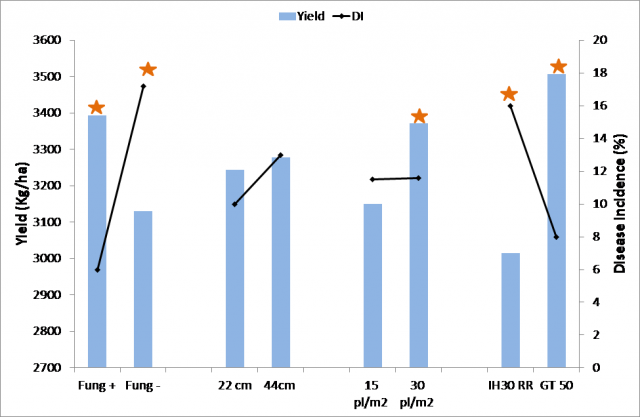
Other potential impacts of crop row spacing on sclerotia
In 2016, Kyran Brooks (Centre for Crop and Disease Management, CCDM and now with Landmark) as part of his Honours studies, conducted a survey of canola paddocks across the WA grain-belt. The main focus of the study was to determine where, within the canola stem, the majority of sclerotia sclerotes occur. This information would then give some indication of the potential for harvest management techniques, such as narrow windrow burning, for subsequent control of sclerotia.
Canola plants infected with SSR were randomly collected from 82 canola fields at the seed development growth stage. Agronomic, variety and management information was recorded for each collection site, including crop row spacing.
Infected canola plants were dissected and the sclerotia distribution, quantity and size fractions counted. Assessment of the 820 canola plants showed that success of interception of S. sclerotiorum sclerotia above a nominal 15 cm harvest cutting was influenced by both pollination type (P<0.001) and row spacing (P<0.001). The study found that 74% (SE±2.1) of sclerotia would be intercepted at a 15 cm harvest cutting height in hybrid canola varieties planted on 25 cm row spacing. When the row spacing was widened to 30 cm, sclerotia interception was reduced to 64% (SE±2.1). Sclerotia interception for open-pollinated varieties was 58% (SE±2.8) and 48% (SE±4.5) when planted at 25 and 30 cm row spacing respectively at the 15 cm harvest cutting height.
Kyran concluded that the study demonstrates that narrow windrow burning of canola residue is an effective tool in reducing S. sclerotiorum sclerotia recruitment into the soil. Although high percentages of sclerotia can be captured during canola harvesting, the study also demonstrated that the interception of sclerotia above a harvest cutting height of 15 cm can be variable, affected by variety and management.
Crop row spacing
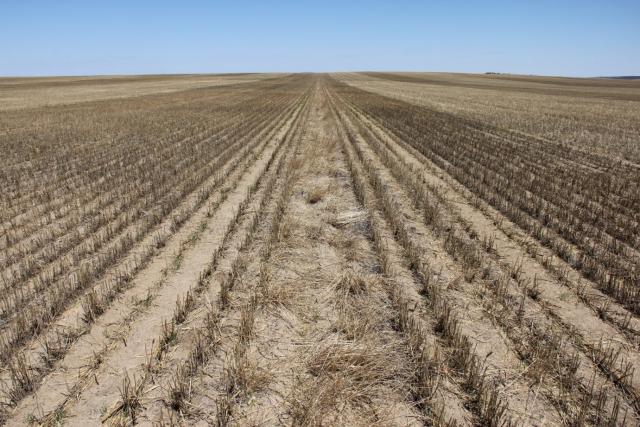
Glen Riethmuller (and Catherine Borger), of DPIRD, conducted a long term rotation trial at Merredin from 2003 to 2013. Crop type, sowing rate and herbicide treatments varied between the years, but the same 4 row spacings were tested each year and a stubble burning treatment was also applied to half of the plots over the course of the experiment.
Crop density was not affected by row spacing. Crop yield was consistently increased at narrow row spacing. This would be partially due to reduced weed competition, but may also be a result of canopy closure at an earlier stage, increased light interception, reduced evaporation and reduced intraspecies competition for resources. There was increased annual ryegrass density in the wide rows and this may have negated any advantage of increased soil moisture (available for the crop), as the weeds would compete with the crop and utilise stored soil moisture prior to crop maturity. Narrow row spacing is not always viable in high-yielding areas, where the resulting crop residue is difficult to manage during the subsequent seeding operation. Where narrow row spacing is not practical, a range of other techniques can be used to increase crop competition, including increased crop density, choice of competitive cultivar and use of appropriate crop orientation.
Use of narrow row spacing combined with residue burning was sufficient to reduce annual ryegrass seed production at harvest to 0–3 seeds m² in the final 4 years of the trial. It is clear that improved crop agronomy, through increased crop competition and physical weed control, through weed seed destruction at harvest, should be used to develop effective and inexpensive Integrated Weed Management (IWM) programmes.
| Burnt | Unburnt | |||||||
| Year | 9 cm | 18 cm | 27 cm | 36 cm | 9 cm | 18 cm | 27 cm | 36 cm |
| 2003 | 120 | 117 | 170 | 141 | 324 | 296 | 702 | 382 |
| 2004 | 42 | 117 | 213 | 313 | 318 | 312 | 757 | 1001 |
| 2005 | 147 | 221 | 354 | 1101 | 375 | 558 | 1930 | 1581 |
| 2006 | 5 | 5 | 22 | 13 | 14 | 18 | 29 | 27 |
| 2007 | 6 | 23 | 28 | 105 | 25 | 54 | 424 | 789 |
| 2009 | 55 | 152 | 159 | 622 | 140 | 319 | 3056 | 3468 |
| 2010 | 3 | 1 | 6 | 17 | 17 | 24 | 36 | 173 |
| 2011 | 2 | 0 | 0 | 17 | 159 | 162 | 334 | 552 |
| 2012 | 3 | 0 | 4 | 10 | 60 | 50 | 135 | 287 |
| 2013 | 0 | 5 | 0 | 0 | 2 | 1 | 51 | 171 |
Crop row orientation
The competitive ability of cereal crops can be increased by orientating crop rows at a right angle to the sun light direction, that is, sow crops in an east-west direction. East-west crops more effectively shade weeds in the inter-row space than north-south crops. The shaded weeds have reduced biomass production and reduced seed set. In particularly weedy paddocks, the reduced weed growth leads to increased crop yield.
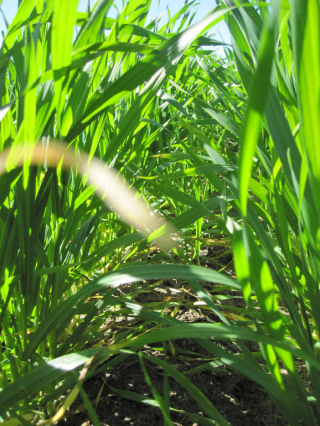
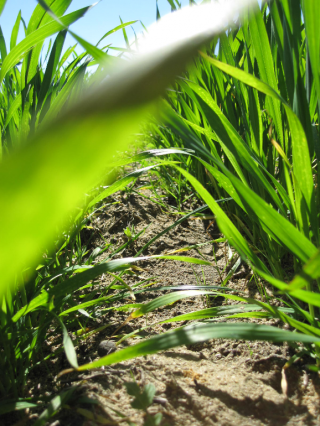
Weed specialist Dr Catherine Borger (DPIRD) studied the effects of crop row orientation on wheat and barley crops in 2010 and 2011. Wheat and barley crops were sown in an east–west (EW) or north–south (NS) direction, at a high or low seeding rate, in three field trials in 2010 and 2011. The three locations were; Merredin, Wongan Hills and Katanning. The average level of light (plant available radiation, PAR) available to the annual ryegrass (Lolium rigidum) growing in the inter-row space of EW crops compared with NS crops was 78% to 91% at crop tillering, 39% to 56% at stem elongation, 28% to 53% at boot/anthesis and 41% to 59% at grain fill. Reduced PAR in the EW crop rows resulted in reduced annual ryegrass seed production in five of the six trials. There was an average of 2968 and 5705 annual ryegrass seeds per m² in the EW and NS crops. Availability of PAR was not influenced by crop seeding rate, but the high seeding rate reduced annual ryegrass seed production in three of the six trials. There was an average of 3354 and 5092 seeds per m² in the crops with high and low seeding rate. Increased competitive ability of crops (through increased interception of PAR or increased crop density) was highly effective in reducing annual ryegrass seed production and is an environmentally friendly and low cost method of weed suppression.
| Year | Location | Annual ryegrass seeds/m2 in east-west crops | Annual ryegrass seeds/m2in north-south crops |
| 2010 | Merredin | 503 | 911 |
| Wongan Hills | 24 | 300 | |
| Katanning | 529 | 465 | |
| 2011 | Merredin | 27 | 125 |
| Wongan Hills | 2 610 | 6 155 | |
| Katanning | 14 113 | 26 276 |
For further information refer to East-west orientation for improved crop competition webpage.
Soil amelioration
A non-wetting soil surface, herbicide resistant weeds and sub-soil constraints can be major limiting factors to cropping on many of WA’s soils. Performing some sort of amelioration to correct soil constraints can have a significant impact on the competitive ability of crops. However, there will also be a change to biological factors such as weeds. In some instances we have some information on how the weeds will behave following soil amelioration treatments but in other areas there is still a need to do further research. This is also the case for how soil applied herbicides may react.
A trial was established by David Hall (DPIRD) in 2012 at Esperance Downs Research Station to compare a number of treatments for ameliorating soil water repellence. Since 2012 when the trial began the weed burden has remained steady in the plots that were renovated to improve the soil water repellence with either an inversion plough, spading with or without clay spreading and clay spread with only shallow inclusion (Figure 5.)
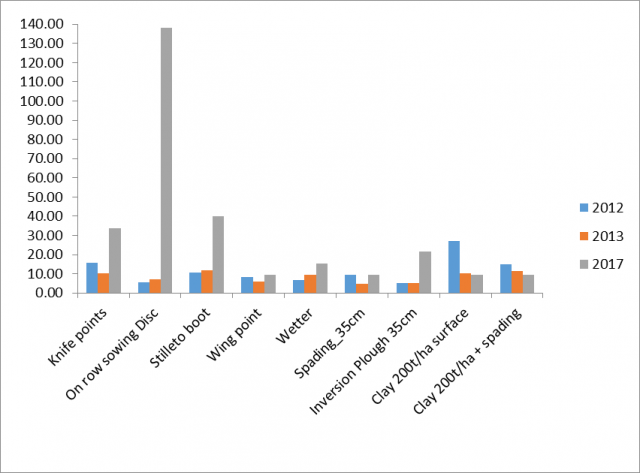
Data was not recorded between 2014-2016 but it is noticeable that the treatments designed to mitigate against soil water repellence through seeding points etc. have experienced an increasing weed burden. The dominant weed is silver grass (Vulpia myuros), a weed that is difficult to control in the cereal rotations, Figure 6 and 7.
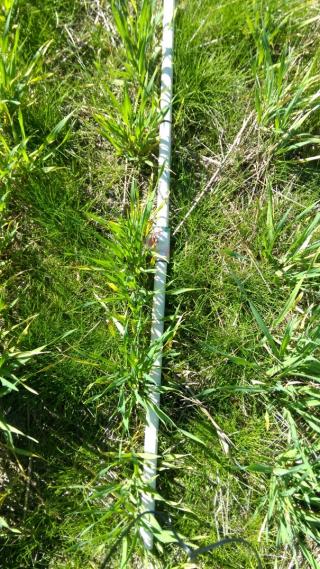
Inversion ploughing
Inversion ploughing has been investigated as a means of managing herbicide resistance weeds and soil constraints in WA, for more than 15 years. Alex Douglas and Sally Peltzer, both from DPIRD, found that mouldboard ploughing reduced the number of annual ryegrass seedlings by over 95% at sites in Katanning and Beverly in 2002, compared with the other tillage treatments (disk ploughing, full cut and no-till tillage). Peter Newman (formally DAFWA) and Stephen Davies (DPIRD) also had consistent success with weed control and lime incorporation in the northern agricultural region.
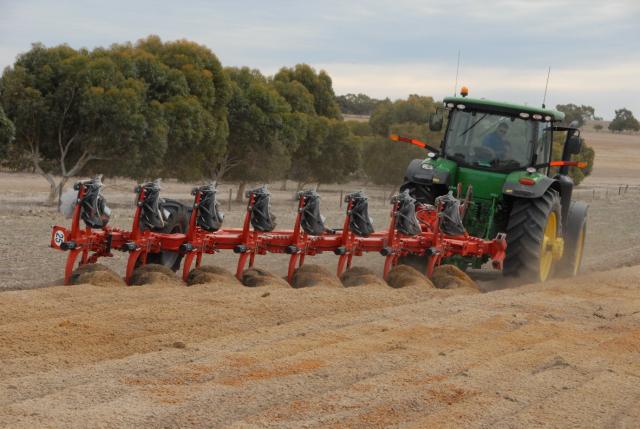
Soil inversion through mouldboard ploughing drastically changes the topsoil. In sands, the most common soil type inverted in Western Australia, the soils typically lack secondary structure. Soil inversion results in a large reduction in the soil’s bulk density, topsoil organic carbon content and breaks up remnant root systems, root channels and fungal hyphae which bind the soil. These soil profile changes can be beneficial through the amelioration of water repellence, reduced compaction to the working depth and deep placement of soil amendments, nutrients and weed seeds but can have implications for seeding crops.
Tom Edwards (DPIRD, Esperance) has been investigating how the behaviour of pre-emergent herbicides can change when applied to inverted and amended soils. Although it is still early days, field trials conducted in Corrigin and Coomalbidgup during 2017, confirm that pre-emergent herbicides can contribute to poor crop establishment in the first year after inversion tillage, Figure 8.
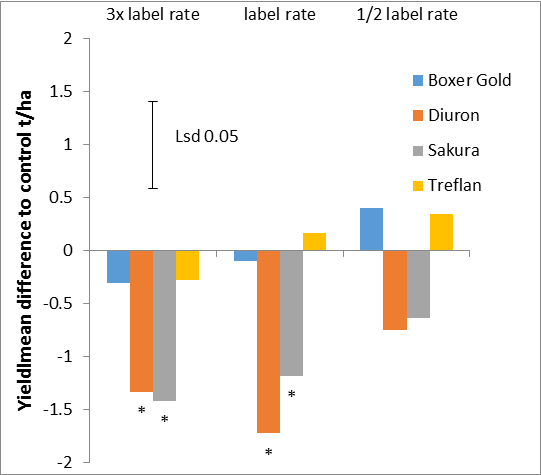
After inversion ploughing Diuron® caused crop damage in barley. Crop damage caused by Boxer Gold® depended on the planting system employed. Sakura® was tolerated by wheat but not barley. Treflan® was tolerated in barley and Logran® was tolerated in wheat.
Lack of organic matter in the surface layers due to inversion tillage can lead to increased phytotoxicity and leaching of some pre-emergent herbicides, though the effect varies depending on the active constituents and their interaction with soil or environmental conditions.
Further trials are underway to determine what effect inversion tillage might have on pre-emergent herbicides several years after deep tillage, how this will impact break crop species and what agronomic changes are required to achieve the best crop performance and weed control.
For more information refer to the Understanding interactions between pre-emergent herbicides and inversion tillage.
Deeper deep ripping – what are the effects on weeds?
Soil renovation techniques, such as deeper deep ripping, provide crop benefits by improving the soil condition allowing plant roots better access to water and nutrients. There is a requirement for more research into techniques to achieve good crop establishment and weed control post soil renovation to capitalise on the benefits of deeper deep ripping (DPIRD).
Deeper deep ripping can leave the soil surface uneven resulting in poor plant establishment. Poor plant establishment is the result of difficulty in managing seeding depth due to an uneven soil surface after ripping as well as the bar sinking into loose soil (DPIRD 2018). The resulting patchy germination and thus reduced weed competition may be combatted by upping the seeding rate to increase competition in weedier patches of the paddock.
This season, Bonnie Jupp and Bindi Isbister (DPIRD) will be conducting a trial at a property east of Geraldton to gain a better understanding of weed biology and prevalence after soil renovation to raise awareness and improve management. Strips will be left un-ripped and high seeding rates will be tested to observe crop and weed establishments in the different treatments.

